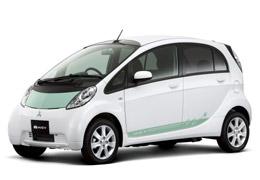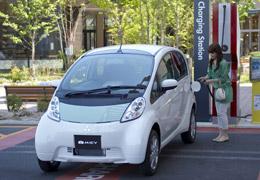|
Home | News | Road Tests | ||||||||||||||||||||||||||||||||||||||||||||||||||||||||||||||||||||
Mitsubishi Motors to release new-generation EV
Home > News > Mitsubishi 7th June, 2009Mitsubishi Motors Corporation has unveiled the production version of the i-MiEV new-generation electric vehicle (EV), describing it as "the pioneer that will open the door to the next 100 years of our automobile society." The Mitsubishi i-MiEV will go on sale on the Japanese market in late July of this year. The i-MiEV represents the crystallisation of some 40 years of electric vehicle development at Mitsubishi Motors. The company is presenting the production Mitsubishi i-MiEV as the ultimate eco-friendly car, a solution to the various challenges the automobile faces today including environmental pollution, potential global warming and the depletion of petroleum-based energy supplies. The company will continue its extensive collaboration with both private and public sectors in Japan and overseas in developing infrastructure to promote ownership of EVs. Mitsubishi Motors expects to distribute, on a maintenance lease basis, some 1,400 i-MiEV models in fiscal 2009 principally to corporations and to local authorities. The company plans to start sales of Mitsubishi i-MiEV to individuals in April 2010 and will start taking orders in late July of this year. The Mitsubishi i-MiEV makes maximum use of the long wheelbase that stems from its base model the "i" mini-car's rear mid-ship lay-out to install a large capacity lithium-ion drive battery under the floor and the power unit under the luggage compartment. This provides a cruising range that is ample for everyday use without compromising the generous seating or luggage space of the "i." The introduction of the MiEV OS (MiEV Operating System) - an advanced integrated vehicle management system into which the company has poured its wealth of know-how garnered from many years of EV research and development - has provided the kind of high performance and reliability that befits a new generation EV. Principal product features (1) Zero drive-time CO2 emissions The Mitsubishi i-MiEV is a zero-emissions vehicle (ZEV) which produces no CO2 emissions while being driven. Even when the CO2 gas emitted at power generating stations is taken into consideration, the i-MiEV generates approximately one-third of the CO2 produced by the petrol "i" mini-car (Calculated in-house based on the average of electric energy frameworks in Japan). (2) Driven 100% by electrical power The i-MiEV is very economical because it only uses electrical energy as its power source. Also, depending on electric power company rate fees, the running cost can be reduced further by charging the battery when off-peak (late night) rates apply. (3) Quiet, agile, comfortable performance The i-MiEV delivers the quiet and comfortable motoring experience only possible from an internal combustion engine-less EV. Maximising the excellent response and high low-end torque inherent to its electric motor i-MiEV enables a level of responsive and powerful performance that surpasses that of the petrol-powered turbo engine Mitsubishi "i" mini-car. (4) Ample range for everyday mini-car use The i-MiEV has a single-charge range of up to 160 kms in the Japanese 10-15 mode urban driving pattern (subject to driving circumstances and weather conditions). This gives it a range that is ample for everyday mini-car use in Japan, where it is considered 90% of cars travel less than 40 kms per week day (Mitsubishi research). (5) 3 ways to charge the battery The i-MiEV uses a 3-way charging system that allows the drive battery to be charged at home or when out and about. For normal charging the i-MiEV is connected to either a standard 100-volt or 200-volt domestic outlet using the charging cables supplied with the vehicle. The Mitsubishi i-MiEV's battery can also be "quick charged" at quick-charge stations which are currently being established throughout Japan. Charging time guide*
Advanced technology (1) Main powertrain components a. Drive battery The Mitsubishi i-MiEV is powered by a very high energy-density lithium-ion battery manufactured by Lithium Energy Japan***. The large-capacity drive battery is comprised of 88 lithium-ion cells connected in series and is installed under the floor in the centre of the vehicle. This configuration contributes to outstanding handling and stability due to the car's low centre of gravity.
b. Motor (power unit) The i-MiEV uses a high-efficiency compact and light weight permanent magnet synchronous electric motor specially developed for the vehicle. It generates maximum torque from low engine speeds to deliver powerful response and a comfortable ride experience. When the vehicle slows down the regenerative brake system causes the motor to operate as a generator. The electrical energy recovered is stored in the drive battery. c. Transmission The i-MiEV uses a light weight and compact single-speed reduction gear transmission, exploiting the high low-end torque inherent to the electric motor and eliminating the need for complex gear shifting mechanisms as found in internal combustion engine powered vehicles. d. On-board charger The Mitsubishi i-MiEV comes with a compact, lightweight on-board charger that allows the drive battery to be charged using a domestic 100V/200V AC line. e. DC/DC converter The DC/DC converter is used to charge the 12-volt auxiliary battery and power electrical equipment. It is integrated with the on-board charger in a single unit to reduce size and weight.
f. Inverter The i-MiEV's motor is driven by an alternating current. The inverter converts high-voltage direct current from the drive battery to alternating current and supplies motor with the power required to drive the vehicle. (2) Combination meter display The combination meter instrument cluster is comprised of a power meter that presents a visual display of power consumption and energy recovery status, a drive battery residual charge indicator that indicates how much remaining power there is left in the drive battery, and an available range indicator that displays an estimate of how far the vehicle can be driven on the basis of average power consumption over the last few kilometres. (3) Shift selector The shift selector provides the three positions described below that allow the driver to choose between maximum fun, maximum economy or maximum regenerative brake bias.
(4) Climate control The Mitsubishi i-MiEV's climate control system features air conditioning with an electrically powered compressor and a heating system which circulates warm water heated by an electric heater. The control dial provides six-step manual adjustment of both cooling and heating temperatures. The system reduces power consumption by minimising occasions when both cooling unit and the heater operate together. (5) Safety features a. Drive battery protected by sturdy frame The high-voltage system, battery pack included, is located inside the body frame and is further protected by a well-crib frame against damage from any direction of impact. b. Integrated vehicle management system: MiEV OS The MiEV OS (MiEV Operating System) gathers data and information from all the major EV components to provide integrated management of the i-MiEV's performance. The advanced management system constantly monitors battery status and the energy recovered from the regenerative brakes while regulating output to ensure smooth and powerful acceleration from a full stop. As a result the system optimises and minimises energy consumption while delivering road performance that is comfortable, safe and reassuring. Other equipment and trim (1) Body colours The range of 8 body finishes includes monotones and two types of 2-tone colour schemes. a. Monotones: Three monotone colours are offered: White Solid, Cool Silver Metallic and Raspberry Red Pearl (factory option). b. 2-tone schemes (factory option): (2) LED headlamps and rear combination lamps The i-MiEV is the first mini-car* and the first Mitsubishi Motors model to use LED headlamps, which throw a longer and wider low-beam pattern while also cutting power consumption. The rear combination lamps also use fast-illuminating LED emitters for the tail and stop lamps, making these lamps more instantly visible to following vehicles. * As of end May 2009, according to Mitsubishi Motors research. (3) PBS-bamboo fibre Green Plastic tailgate trim The Mitsubishi i-MiEV uses PBS (polybutylene succinate) - bamboo fibre Green Plastic for the tailgate interior trim. The use of PBS-bamboo fibre cuts life-cycle emissions (from extraction of raw materials to final disposal of product) of CO2 by some 10 per cent compared with polypropylene. (4) Mitsubishi Multi-Entertainment System (MMES) The i-MiEV is available with the Mitsubishi Multi-Entertainment System (with a 7-inch display and SSD navigation) that is built around solid state drive (SSD) technology to offer outstanding power saving and shock resistant properties. MMES is a factory-fitted option. The navigation database can be updated using SD flash cards and the company plans to use this feature to display the location of battery charging stations as they become available. Mitsubishi i-MiEV specifications
| ||||||||||||||||||||||||||||||||||||||||||||||||||||||||||||||||||||
More Mitsubishi News .....
here
About | Car Clubs | Home | News | Road Ramblings | Road Tests | Subscribe | Top Drive © 2009 All rights reserved. Next Car Pty. Ltd. | ||||||||||||||||||||||||||||||||||||||||||||||||||||||||||||||||||||





